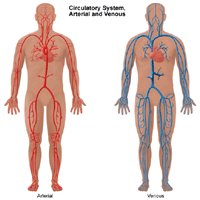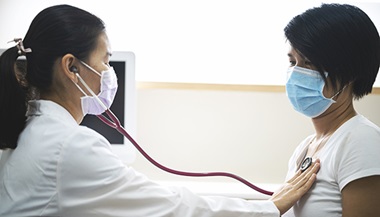Overview of the Vascular System
What is the vascular system?
The vascular system is made up of the vessels that carry blood and lymph fluid through the body. It's also called the circulatory system. The arteries and veins carry blood all over the body. They send oxygen and nutrients to the body tissues. And they take away tissue waste. The lymph vessels carry lymphatic fluid. This is a clear, colorless fluid made of water and blood cells. The lymphatic system is part of the immune system that helps rid the body of toxins and waste. It does this by filtering and draining lymph away from each region of the body.
The vessels of the blood circulatory system are:
-
Arteries. These are blood vessels that carry oxygenated blood away from the heart to the body.
-
Veins. These are blood vessels that carry blood from the body back into the heart.
-
Capillaries. These are tiny blood vessels between arteries and veins that distribute oxygen-rich blood to the body.
When the heart pumps, blood moves through the circulatory system. Blood leaving the heart through the arteries is full of oxygen. The arteries branch off into smaller and smaller tubes. These bring oxygen and other nutrients to the cells of the body's tissues and organs. The smallest tubes are called capillaries. As blood moves through the capillaries, the oxygen and other nutrients move out into the cells. Then waste matter from the cells goes into the capillaries. As the blood leaves the capillaries, it moves through the veins. Veins merge into larger tubes to carry the blood back to the heart.
The vascular system is also an important part of other body systems. Examples include:
-
Respiratory system. As blood flows through the capillaries in the lungs, carbon dioxide is removed and oxygen is picked up. The carbon dioxide leaves the body through the lungs. And the oxygen is sent to the body tissues by the blood.
-
Digestive system. As food is digested, blood flows through the capillaries in the intestines. These tubes pick up nutrients. These include glucose (sugar), vitamins, and minerals. These nutrients are sent to the body tissues by the blood.
-
Kidneys and urinary system. Waste materials from the body tissues are filtered out from the blood as it flows through the kidneys. The waste then leaves the body in the form of urine.
-
Temperature control. Control of the body's temperature is helped by the flow of blood in the different parts of the body. Heat is made by the body's tissues. This happens as they break down nutrients for energy, make new tissue, and give up waste matter.
What is vascular disease?
A vascular disease is a condition that affects the arteries and veins. Most often, a vascular disease affects blood flow. It may do this by blocking or making blood vessels weaker. Or it may do this by causing damage to the valves that are in veins. Organs and other body areas may be harmed by vascular disease due to partly or fully blocked blood flow.
What causes vascular disease?
Causes of vascular disease include:
-
Atherosclerosis. This is a buildup of plaque. Plaque is a deposit of fatty substances, cholesterol, cell waste, calcium, and fibrin. It can build up in the inner lining of an artery. It's the most common cause of vascular disease. It's not known how atherosclerosis starts or what causes it. It's a slow, ongoing disease that gets worse over time. It may start as early as childhood. But the disease can also get worse quickly. It causes the buildup of fatty deposits along the innermost layer of the arteries. This thickening narrows the arteries. It can lessen or fully block the flow of blood to organs and other body tissues.
-
Blood clots. A blood vessel may be blocked by an embolus. This is a tiny mass of debris that moves through the bloodstream. Or it may be blocked by a thrombus. This is a blood clot.
-
Inflammation. In general, inflammation of blood vessels is referred to as vasculitis. This includes a range of disorders. Inflammation may lead to narrowing and blockage of blood vessels.
-
Injury. Injury of the blood vessels may lead to inflammation or infection. This can damage the blood vessels and lead to narrowing and blockage.
-
Genetic. Some conditions of the vascular system are inherited.
What are the effects of vascular disease?
The functions of the blood vessels include supplying all organs and tissues of the body with oxygen and nutrients. They include removing waste products, fluid balance, and other functions. Because of all these functions, conditions that affect the vascular system may affect the part(s) of the body supplied by a certain vascular network.
Examples of the effects of vascular disease include:
-
Coronary artery disease. This can cause heart attack or angina (chest pain).
-
Cerebrovascular disease. This can cause stroke or transient ischemic attack (TIA). TIA is a short-term loss of blood flow to an area of the brain. It usually last less than 5 minutes but not longer than 24 hours, with complete recovery.
-
Peripheral arterial disease. This may cause claudication. This is pain in the thigh, calf, or buttocks that occurs when walking. It can also cause critical limb ischemia. This is lack of blood supply and oxygen to the limb or leg at rest.
-
Vascular disease of the great vessels. This can cause an aortic aneurysm. This is a bulging, weakened area in the wall of a blood vessel due to an abnormal widening or ballooning. It can also cause coarctation of the aorta. This is narrowing of the aorta, the largest artery in the body. It can also cause Takayasu arteritis. This is a rare inflammatory disease that affects the aorta and its branches.
-
Thoracic vascular disease. It can cause thoracic aortic aneurysm. This is a bulging, weakened area in the wall of a blood vessel. It causes an abnormal widening or ballooning in the chest (thoracic) part of the aorta.
-
Abdominal vascular disease. It can cause an abdominal aortic aneurysm. This is a bulging, weakened area in the wall of a blood vessel. It causes an abnormal widening or ballooning in the belly (abdominal) part of the aorta.
-
Peripheral venous disease. This can cause deep vein thrombosis (DVT). DVT is a blood clot in a deep vein in the muscles of the leg. This disease can also cause varicose veins.
-
Lymphatic vascular diseases. These can cause lymphedema. This is swelling caused by problems of the normal draining of the lymph nodes.
-
Vascular diseases of the lungs. These can cause granulomatosis with polyangiitis. This is an uncommon disease in which the blood vessels are inflamed. It mainly affects the respiratory tract and the kidneys. Other diseases include angiitis (inflammation of blood vessels) and hypertensive pulmonary vascular disease. This is high blood pressure in the lungs' blood flow.
-
Renal (kidney) vascular diseases. These can cause renal artery stenosis (blockage of a renal artery). They can also cause fibromuscular dysplasia. This is a condition that makes the walls of medium-sized arteries weak. It occurs most often in young women of childbearing age.
-
Genitourinary vascular diseases. These can cause vascular erectile dysfunction (impotence).
Vascular diseases may affect more than one of the body's systems at a time. Because of this, many types of healthcare providers treat vascular problems. Specialists in vascular medicine or surgery work closely with providers in other specialties. These include providers who specialize in internal medicine, interventional radiology, and cardiology.






